engine Lancia Delta 2010 Owner handbook (in English)
[x] Cancel search | Manufacturer: LANCIA, Model Year: 2010, Model line: Delta, Model: Lancia Delta 2010Pages: 276, PDF Size: 5.31 MB
Page 139 of 276
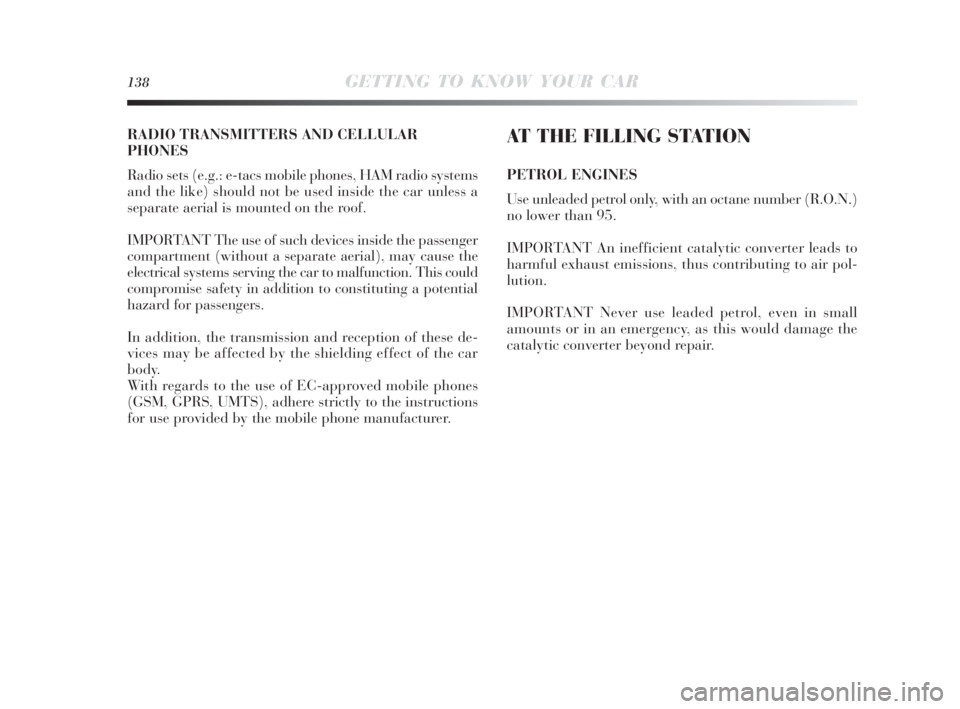
138GETTING TO KNOW YOUR CAR
RADIO TRANSMITTERS AND CELLULAR
PHONES
Radio sets (e.g.: e-tacs mobile phones, HAM radio systems
and the like) should not be used inside the car unless a
separate aerial is mounted on the roof.
IMPORTANT The use of such devices inside the passenger
compartment (without a separate aerial), may cause the
electrical systems serving the car to malfunction. This could
compromise safety in addition to constituting a potential
hazard for passengers.
In addition, the transmission and reception of these de-
vices may be affected by the shielding effect of the car
body.
With regards to the use of EC-approved mobile phones
(GSM, GPRS, UMTS), adhere strictly to the instructions
for use provided by the mobile phone manufacturer.AT THE FILLING STATION
PETROL ENGINES
Use unleaded petrol only, with an octane number (R.O.N.)
no lower than 95.
IMPORTANT An inefficient catalytic converter leads to
harmful exhaust emissions, thus contributing to air pol-
lution.
IMPORTANT Never use leaded petrol, even in small
amounts or in an emergency, as this would damage the
catalytic converter beyond repair.
001-142 Delta 3ed gb 30-11-2009 11:22 Pagina 138
Page 140 of 276
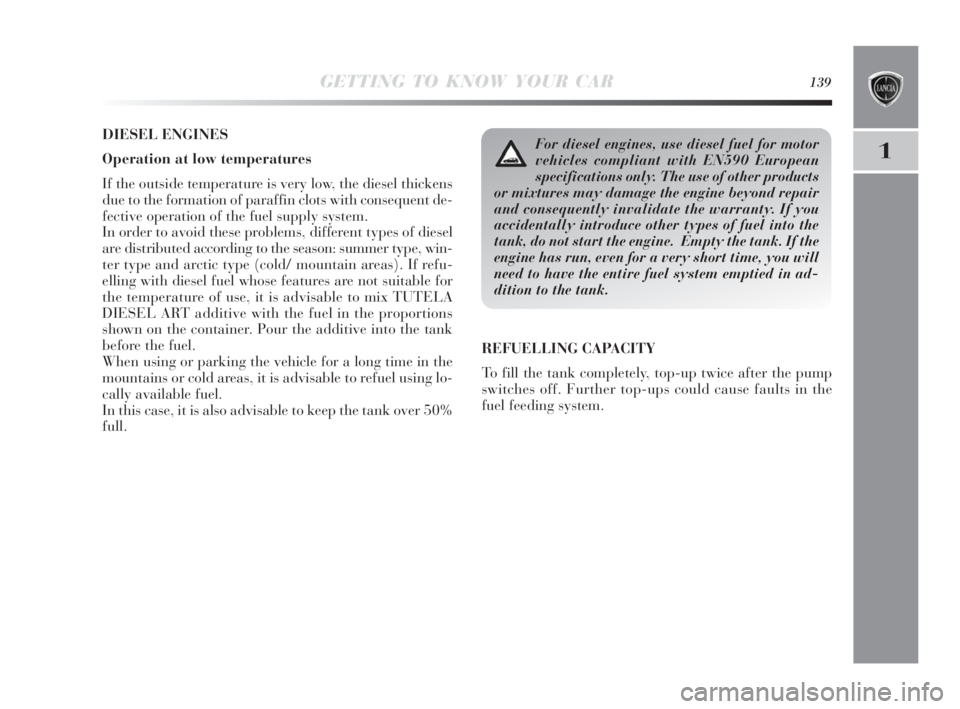
GETTING TO KNOW YOUR CAR139
1
DIESEL ENGINES
Operation at low temperatures
If the outside temperature is very low, the diesel thickens
due to the formation of paraffin clots with consequent de-
fective operation of the fuel supply system.
In order to avoid these problems, different types of diesel
are distributed according to the season: summer type, win-
ter type and arctic type (cold/ mountain areas). If refu-
elling with diesel fuel whose features are not suitable for
the temperature of use, it is advisable to mix TUTELA
DIESEL ART additive with the fuel in the proportions
shown on the container. Pour the additive into the tank
before the fuel.
When using or parking the vehicle for a long time in the
mountains or cold areas, it is advisable to refuel using lo-
cally available fuel.
In this case, it is also advisable to keep the tank over 50%
full.REFUELLING CAPACITY
To fill the tank completely, top-up twice after the pump
switches off. Further top-ups could cause faults in the
fuel feeding system.For diesel engines, use diesel fuel for motor
vehicles compliant with EN590 European
specifications only. The use of other products
or mixtures may damage the engine beyond repair
and consequently invalidate the warranty. If you
accidentally introduce other types of fuel into the
tank, do not start the engine. Empty the tank. If the
engine has run, even for a very short time, you will
need to have the entire fuel system emptied in ad-
dition to the tank.
001-142 Delta 3ed gb 30-11-2009 11:22 Pagina 139
Page 142 of 276

GETTING TO KNOW YOUR CAR141
1
PROTECTING THE ENVIRONMENT
The devices for reducing petrol engine emissions are the
following:
❍three-way catalytic converter;
❍Lambda sensors;
❍fuel evaporation control system.
In addition, do not let the engine run, even for a test, with
one or more spark plugs disconnected.
The devices for reducing diesel fuel engine emissions are
the following:
❍oxidising catalytic converter;
❍exhaust gas recirculation system (E.G.R.).
❍diesel particulate filter (DPF) (for versions/markets,
where provided).
The catalytic converter reaches high temper-
atures during operation. Do not park on
grass, dry leaves, pine needles or other flam-
mable material: fire risk.
DIESEL PARTICULATE FILTER (DPF)
(for versions/markets, where provided)
The Diesel Particulate Filter is a mechanical filter, inte-
gral with the exhaust system, that physically traps par-
ticulate present in the exhaust gases of Diesel engines. The
diesel particular filter has been adopted to almost totally
eliminate particulate in compliance with current / future
regulations. During normal use of the car, the engine man-
agement control unit records a set of data (e.g.: travel time,
type of route, temperatures reached, etc.) and it will then
calculate the amount of particulate trapped by the filter.
Since this filter physically traps particulate, it should be
regenerated (cleaned) at regular intervals by burning car-
bon particles. The regeneration procedure is controlled au-
tomatically by the engine management control unit ac-
cording to the filter conditions and car use conditions. Dur-
ing the regeneration procedure, the following situations
may occur: limited increase of idle speed, activation of
electric fan, limited increase of smoke, high temperatures
at the exhaust. These are not faults; they do not impair
car performance or damage the environment. If the ded-
icated warning message is displayed, refer to the section
“Instrument panel warning lights” in this chapter.
001-142 Delta 3ed gb 30-11-2009 11:22 Pagina 141
Page 166 of 276
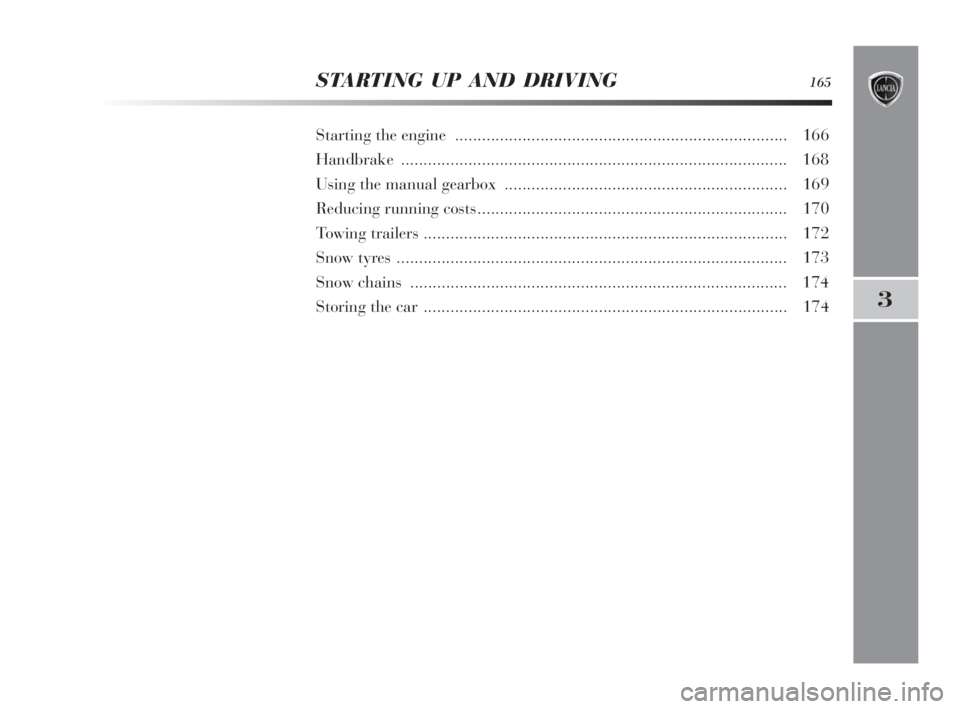
STARTING UP AND DRIVING165
3
Starting the engine .......................................................................... 166
Handbrake ...................................................................................... 168
Using the manual gearbox ............................................................... 169
Reducing running costs..................................................................... 170
Towing trailers ................................................................................. 172
Snow tyres ....................................................................................... 173
Snow chains .................................................................................... 174
Storing the car ................................................................................. 174
165-174 Delta 3ed gb 11-11-2009 12:10 Pagina 165
Page 167 of 276

166STARTING UP AND DRIVING
STARTING THE ENGINE
The car is provided with an electronic engine lock device:
refer to “The Lancia CODE system” paragraph in chap-
ter “1” if you cannot start the engine.
The engine may be noisier during the first few seconds
of operation, particularly after a long period of inactivi-
ty. This does not impair functionality and reliability and
is typical of hydraulic tappets: the distribution system
selected for the petrol engine of your car in order to lim-
it the maintenance required.
In the first period of use, we recommend
avoiding excessive stress for the car (for in-
stance excessive accelerations, extended trav-
el at maximum speed, sudden braking etc.).
With engine off, do not leave the key in the ig-
nition switch on MAR to prevent draining the
battery.
Is is dangerous to let the engine run in en-
closed spaces. The engine depletes oxygen and
discharges carbon dioxide, carbon monoxide
and other toxic gases.
Remember that the brake servo and electric
power steering are not operational until the
engine has been started, therefore more effort
than usual is required on the brake pedal and steer-
ing wheel.
165-174 Delta 3ed gb 11-11-2009 12:10 Pagina 166
Page 168 of 276

STARTING UP AND DRIVING167
3
STARTING PROCEDURE FOR PETROL
VERSIONS
Proceed as follows:
❍engage the handbrake;
❍put the gear lever into neutral;
❍press the clutch pedal down to the floor without touch-
ing the accelerator;
❍turn the ignition key to AVV and release it the moment
the engine starts.
If the engine does not start at the first attempt, return
the ignition key to STOP before repeating the procedure.
If, when the ignition key is at MAR the
Ywarning light
remains lit together with warning light U, turn the key
to STOP and then back to MAR; if the warning light re-
mains lit, try with the other keys provided with the car.
Contact a Lancia Dealership if you still cannot start the
engine.
PROCEDURE FOR DIESEL VERSIONS
Proceed as follows:
❍engage the handbrake;
❍put the gear lever into neutral;
❍turn the ignition key to MAR: instrument panel warn-
ing lights
mandYwill light up;
❍wait for warning lights
Yandm, to turn off. The
hotter the engine is, the quicker this will happen;❍press the clutch pedal down to the floor without touch-
ing the accelerator;
❍turn the ignition key to AVV as soon as the
mwarn-
ing light goes out. Waiting too long will waste the work
done by the glow plugs.
Release the key as soon as the engine starts.
IMPORTANT When the engine is cold, the accelerator
pedal must be completely released when the key is turned
to AVV.
If the engine does not start at the first attempt, return the
ignition key to STOP before repeating the procedure. If,
when the ignition key is at MAR the
Ywarning light re-
mains lit, turn the key to STOP and then back to MAR; if
the warning light remains lit, try with the other keys pro-
vided with the car. Contact a Lancia Dealership if you still
cannot start the engine.
Warning light mwill blink for 60 seconds
after starting or during prolonged cranking
to indicate a fault in the glow plug preheat-
ing system. Use the car normally if the engine starts
and contact the Lancia Dealership as soon as pos-
sible.
165-174 Delta 3ed gb 11-11-2009 12:10 Pagina 167
Page 169 of 276
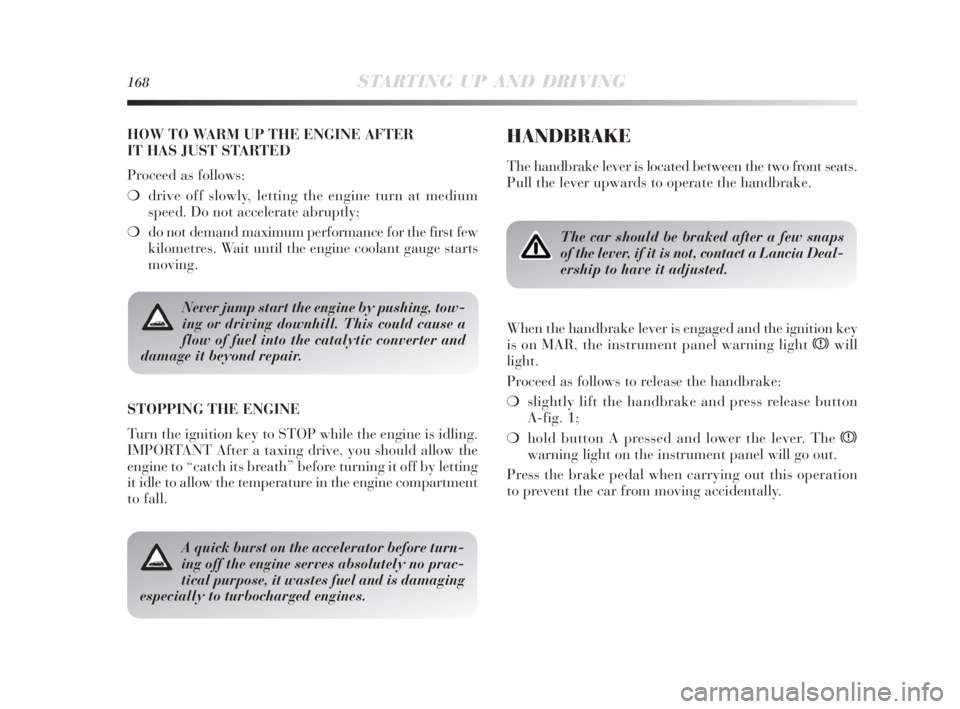
168STARTING UP AND DRIVING
Never jump start the engine by pushing, tow-
ing or driving downhill. This could cause a
flow of fuel into the catalytic converter and
damage it beyond repair.
HOW TO WARM UP THE ENGINE AFTER
IT HAS JUST STARTED
Proceed as follows:
❍drive off slowly, letting the engine turn at medium
speed. Do not accelerate abruptly;
❍do not demand maximum performance for the first few
kilometres. Wait until the engine coolant gauge starts
moving.
STOPPING THE ENGINE
Turn the ignition key to STOP while the engine is idling.
IMPORTANT After a taxing drive, you should allow the
engine to “catch its breath” before turning it off by letting
it idle to allow the temperature in the engine compartment
to fall.
A quick burst on the accelerator before turn-
ing off the engine serves absolutely no prac-
tical purpose, it wastes fuel and is damaging
especially to turbocharged engines.
HANDBRAKE
The handbrake lever is located between the two front seats.
Pull the lever upwards to operate the handbrake.
The car should be braked after a few snaps
of the lever, if it is not, contact a Lancia Deal-
ership to have it adjusted.
When the handbrake lever is engaged and the ignition key
is on MAR, the instrument panel warning light xwill
light.
Proceed as follows to release the handbrake:
❍slightly lift the handbrake and press release button
A-fig. 1;
❍hold button A pressed and lower the lever. The x
warning light on the instrument panel will go out.
Press the brake pedal when carrying out this operation
to prevent the car from moving accidentally.
165-174 Delta 3ed gb 11-11-2009 12:10 Pagina 168
Page 170 of 276

STARTING UP AND DRIVING169
3
PARKING THE CAR
Proceed as follows:
❍stop the engine and engage the handbrake;
❍engage a gear (on a slope, engage first gear if the car
is faced uphill or reverse if it is faced downhill) and
leave the wheels steered.
If the car is parked on a steep slope, it is further advisable
to block the wheels with a wedge or stone.
Do not leave the ignition key on MAR to prevent drain-
ing the battery. Always remove the key when you leave the
car.
Never leave children unattended in the car. Always remove
the ignition key when leaving the car and take it out with
you.
fig. 1L0E0072m
USING THE MANUAL GEARBOX
To engage the gears, press the clutch pedal fully and shift
the gear lever into one of the required positions (the gear
diagram varies according to the different versions and is
shown on the knob or on the plate below the lever fig. 2).
To engage sixth gear, operate the lever by pressing it to-
wards the right in order to avoid engaging fourth gear by
mistake. Use the same action to pass from sixth to fifth
gear.
IMPORTANT Reverse may only be engaged when the car
is at a standstill. With the engine running, wait at least 2
seconds before engaging reverse gear with the clutch
pressed down to the floor in order to avoid damaging or
scraping the gears.
fig. 2L0E0073m
165-174 Delta 3ed gb 11-11-2009 12:10 Pagina 169
Page 172 of 276
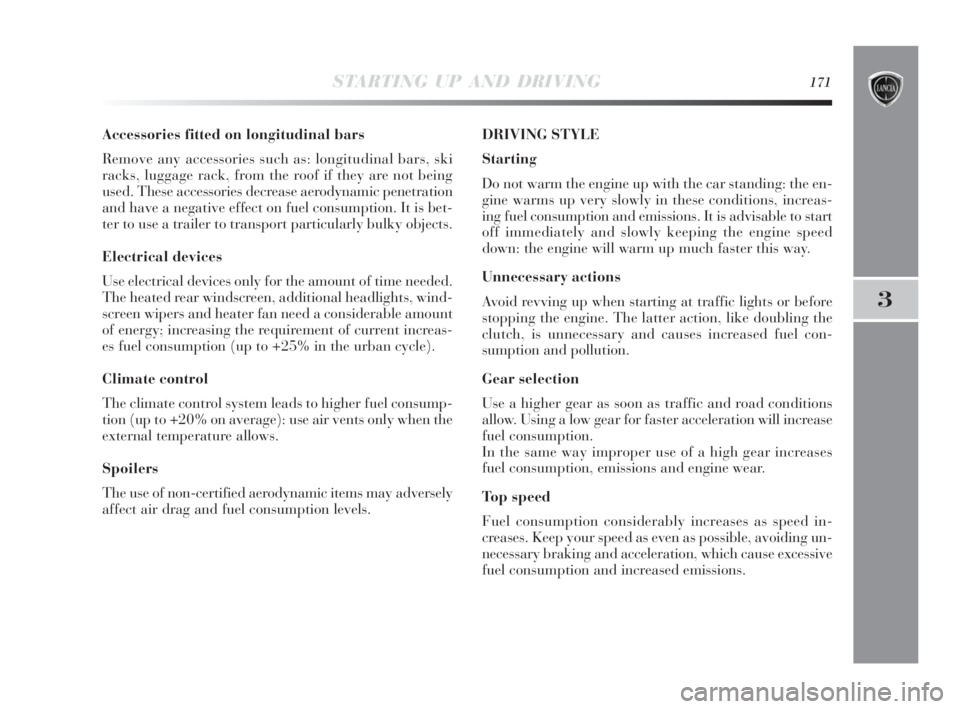
STARTING UP AND DRIVING171
3
Accessories fitted on longitudinal bars
Remove any accessories such as: longitudinal bars, ski
racks, luggage rack, from the roof if they are not being
used. These accessories decrease aerodynamic penetration
and have a negative effect on fuel consumption. It is bet-
ter to use a trailer to transport particularly bulky objects.
Electrical devices
Use electrical devices only for the amount of time needed.
The heated rear windscreen, additional headlights, wind-
screen wipers and heater fan need a considerable amount
of energy; increasing the requirement of current increas-
es fuel consumption (up to +25% in the urban cycle).
Climate control
The climate control system leads to higher fuel consump-
tion (up to +20% on average): use air vents only when the
external temperature allows.
Spoilers
The use of non-certified aerodynamic items may adversely
affect air drag and fuel consumption levels.DRIVING STYLE
Starting
Do not warm the engine up with the car standing: the en-
gine warms up very slowly in these conditions, increas-
ing fuel consumption and emissions. It is advisable to start
off immediately and slowly keeping the engine speed
down: the engine will warm up much faster this way.
Unnecessary actions
Avoid revving up when starting at traffic lights or before
stopping the engine. The latter action, like doubling the
clutch, is unnecessary and causes increased fuel con-
sumption and pollution.
Gear selection
Use a higher gear as soon as traffic and road conditions
allow. Using a low gear for faster acceleration will increase
fuel consumption.
In the same way improper use of a high gear increases
fuel consumption, emissions and engine wear.
Top speed
Fuel consumption considerably increases as speed in-
creases. Keep your speed as even as possible, avoiding un-
necessary braking and acceleration, which cause excessive
fuel consumption and increased emissions.
165-174 Delta 3ed gb 11-11-2009 12:10 Pagina 171
Page 173 of 276
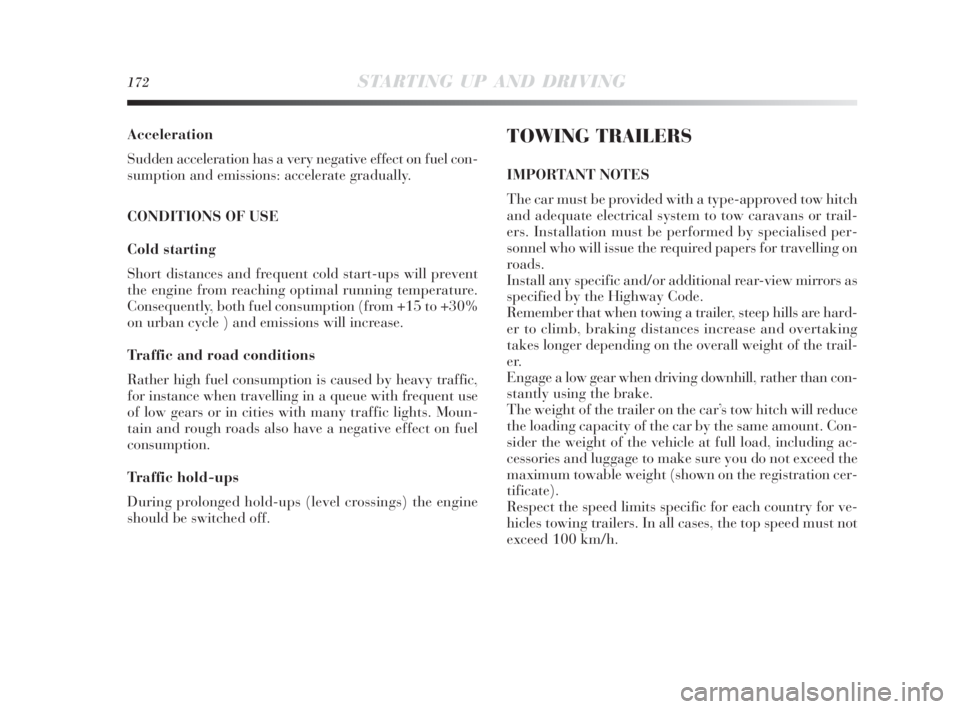
172STARTING UP AND DRIVING
Acceleration
Sudden acceleration has a very negative effect on fuel con-
sumption and emissions: accelerate gradually.
CONDITIONS OF USE
Cold starting
Short distances and frequent cold start-ups will prevent
the engine from reaching optimal running temperature.
Consequently, both fuel consumption (from +15 to +30%
on urban cycle ) and emissions will increase.
Traffic and road conditions
Rather high fuel consumption is caused by heavy traffic,
for instance when travelling in a queue with frequent use
of low gears or in cities with many traffic lights. Moun-
tain and rough roads also have a negative effect on fuel
consumption.
Traffic hold-ups
During prolonged hold-ups (level crossings) the engine
should be switched off.TOWING TRAILERS
IMPORTANT NOTES
The car must be provided with a type-approved tow hitch
and adequate electrical system to tow caravans or trail-
ers. Installation must be performed by specialised per-
sonnel who will issue the required papers for travelling on
roads.
Install any specific and/or additional rear-view mirrors as
specified by the Highway Code.
Remember that when towing a trailer, steep hills are hard-
er to climb, braking distances increase and overtaking
takes longer depending on the overall weight of the trail-
er.
Engage a low gear when driving downhill, rather than con-
stantly using the brake.
The weight of the trailer on the car’s tow hitch will reduce
the loading capacity of the car by the same amount. Con-
sider the weight of the vehicle at full load, including ac-
cessories and luggage to make sure you do not exceed the
maximum towable weight (shown on the registration cer-
tificate).
Respect the speed limits specific for each country for ve-
hicles towing trailers. In all cases, the top speed must not
exceed 100 km/h.
165-174 Delta 3ed gb 11-11-2009 12:10 Pagina 172